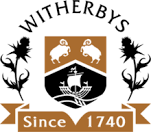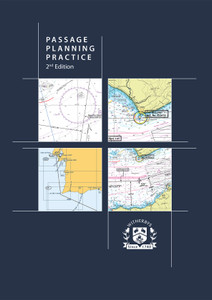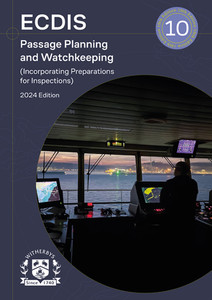
The fully updated 2023 edition of ‘Passage Planning Guidelines’ includes three separate publications presented in a slipcase. These titles cover the latest procedures, guidance and best practice required for good navigational practice.
The following titles are included in the ‘Passage Planning Guidelines’ trilogy:
- ‘Passage Planning Guidelines’
- ‘Safe Nav Watch’
- ‘Teamwork on the Nav Bridge’
‘Passage Planning Guidelines’ focuses on the Appraisal and Planning stages of voyage planning using traditional methods, paper charts and ECDIS, with fully worked examples throughout.
The 2023 edition has been updated to reflect the industry’s changing position on using ECDIS, and ENCs, as the primary means of navigation when passage planning. While still covering all the aspects of traditional paper chart navigation, this edition also includes a detailed overview of passage planning using ECDIS. Passage planning calculation examples are included to increase navigators’ familiarity, and imagery has been updated for both paper charts and ECDIS route planning examples.
‘Safe Nav Watch’ provides guidance on safe navigational watchkeeping, highlighting potential hazards and how these can be avoided. The book contains guidance from experienced mariners, reinforced by best practice.
In this edition, all applicable SOLAS amendments and bridge equipment performance standards have been updated, alongside an in-depth review of the ‘Bridge Equipment’ chapter. New case studies have been added to the ‘Lessons from Navigation Incidents’ chapter, highlighting errors navigators have made on voyage and what the industry best practice is to prevent incidents from happening again. Chapter 5 – ‘Bridge Practices – Weather’ has also been expanded to incorporate tropical revolving storms, their locations and how to navigate safely when one forms.
‘Teamwork on the Nav Bridge’ is based on original text from a leading trainer of cockpit resource management. The text has been fully revised and updated to reflect the key factors in bridge resource management, and why this is essential when forming the bridge team.
Passage Planning Guidelines 2023 – 2024 Edition
Effective Passage Planning
Passage planning is a process that requires skill and meticulous research. It is not something that should be taken lightly as it carries responsibility for the safety of the ship. The consequences of omitting information and/or failing to safely plan the passage can be serious. The navigation officer preparing the passage plan (the ‘navigator’) must be diligent and seek to produce a comprehensive and detailed ‘berth to berth’ plan based on a full appraisal, taking into account all possibilities and eventualities, while reducing navigational risk.
An effective passage plan, whether completed using paper charts or ECDIS, must:
• Establish appropriate safety settings for each stage of the voyage, taking into account the requirements of the SMS
• clearly define a safe navigational route from berth to berth
• be comprehensive and contain an appropriate level of detail
• reduce navigational risks and include contingency options
• satisfy environmental protection requirements
• be checked visually and electronically
• be reviewed and approved by the Master
• be easy to follow, allowing safe and efficient execution and monitoring of the plan.
In November 2021, the UK Supreme Court reaffirmed the decision that a defective passage plan effectively renders the ship legally unseaworthy. In the case under question, a large container ship went aground. The company was held liable for several million dollars when it was determined that the chart had not been properly updated. It was confirmed that the passage plan (appraisal and planning stages) and subsequent navigation outside a buoyed fairway did not reflect a warning given in a Notice to Mariners. The warning stated that the depths shown on the chart outside the fairway were unreliable and that the waters were shallower than those recorded on the chart.
Therefore, the importance of a well-made passage plan should not be underestimated.
Team Work on the Nav Bridge
Much of the content of this book is abridged from ‘Navigating the Human Element’ by Captain Timothy Crowch, who brings over 40 years’ experience of commercial aviation and 10 years working with the maritime industry. It has been further developed for inclusion in this publication with the author’s permission. As an expert investigator, he participated in a number of high-profile investigations into aviation-related accidents and incidents. His experience and advanced training led him to develop and produce safety awareness training, education and accident prevention programmes for complex industries, including insurance, aviation, maritime and healthcare.
This book highlights the importance of defending against the consequences of human error. It includes guidance on subjects such as situational awareness, decision-making by the bridge team and the concept of bridge resource management (BRM). It also details the importance of keeping fit for duty, ensuring adequate rest and managing the circumstances that contribute to fatigue on board.
Safe Nav Watch
This publication provides guidance on safe navigational watchkeeping and highlights potential issues and pitfalls. It is based on advice and guidance from experienced mariners, reinforced by best practice.
Safe navigation is now more important than ever, as:
• Every mistake is a potential human and environmental catastrophe
• Masters and officers can be faced with fines, if incompetence is proved, as well as potential imprisonment
• incidents can result in reputational damage and financial loss for companies
• every mistake is scrutinised by a global media audience and even small errors are now shown in videos online.
Navigation is regarded as an art despite the fact that it is increasingly dominated by technology. Watchkeeping in the digital age presents the same challenges, just in different forms. The availability of technology should never diminish the importance of watchkeeping and maintaining a proper lookout, or monitoring the ship’s position along a prepared route. As ships have transitioned to ECDIS as their primary means of navigation, it must be remembered that the four stages of passage planning – appraisal, planning, execution and monitoring (APEM) – are just as critical whether the navigating officer is using an ECDIS or paper charts.
Passage Planning Guidelines 2023 – 2024 Edition
Chapter 1 – Introduction
1 Effective Passage Planning
1.1 The Requirement for a Comprehensive Passage Plan
1.2 The Four Stages of Planning
1.3 Responsibility
1.4 Key to Symbols
Chapter 2 – Appraisal
2 Gathering Information
2.1 Carriage Requirements for Charts and Nautical Publications
2.2 Preliminary Research – Overview
2.3 Destination and Routeing
2.4 Tidal Data and UKC Calculations
2.5 ‘Ocean Passages for the World’
2.6 ‘Passage Planning Guides’
2.7 Weather and Environment
2.8 Charts, Update and Review
2.9 Additional Considerations for Passage Planning in Ice Regions
2.10 Preliminary Research – Other Considerations
2.11 Appraisal Findings
Chapter 3 – Passage Planning on Paper Charts
3 Planning using Paper Charts
3.1 Voyage Overview
3.2 Chart Preparation
3.3 Plotting Courses
3.4 Speed on Passage Legs
3.5 Pilotage
3.6 Port Approaches
3.7 Coastal and Ocean Passages
3.8 Contingency Planning
3.9 Completion of the Planning Stage
3.10 Coastal Passage – Example
Chapter 4 – Passage Planning on ECDIS
4 Planning using ECDIS
4.1 ECDIS Overview
4.2 Voyage Overview
4.3 ECDIS Settings
4.4 Route Creation
4.5 Mariner-added Objects
4.6 Manual Updates
iv Passage Planning Guidelines
4.7 Route Check
4.8 Bridge Team Briefing and Master’s Approval
4.9 Execution
Annexes
Annex A – Example Appraisal Report Format
Annex B – Passage Planning Checklists
Annex C – ECDIS Planning Checklists
Annex D – Parallel Indexing
Annex E – Example Passage Plan Worksheet Format
Annex F – Example of Passage Planning Notes
Annex G – ECDIS References
Annex H – List of Useful Publications
Annex I – ECDIS Display Options
Teamwork on the Nav Bridge
Chapter 1 – What do we Mean by ‘Human Error’?
Chapter 2 – Defences Against the Consequences of ‘Human Error’
2.1 Technology
2.2 Understanding Human Performance
2.3 Communication
2.4 Intervening with Senior Officers
2.5 Protecting Your Eyes
2.6 Target Fascination and Reduced Processing
2.7 Situational Awareness
2.8 Decision-Making
Chapter 3 – Bridge Resource Management (BRM)
3.1 Attitudes
3.2 What Makes an Effective Bridge Team?
Chapter 4 – Working with a Pilot on Board
4.1 What Changes when the Pilot Comes on Board?
Chapter 5 – Keeping Fit for Duty
5.1 Inadequate Rest
5.2 Stress
5.3 Working at Night and in Darkness
5.4 Getting a Good Sleep
Chapter 6 – Fatigue
6.1 How Does Fatigue Affect Performance?
6.2 Napping (Short Shallow Sleep)
6.3 Fatigue Management
Safe Nav Watch
Chapter 1 – Bridge Equipment (Carriage Requirements)
1.1 SOLAS Equipment List for Ships Built Before 2002
1.2 SOLAS Equipment List for Ships Built After 2002
1.3 GMDSS Equipment
1.4 Bridge Equipment Connections
1.5 Bridge Equipment – Performance Standards
Chapter 2 – Bridge Equipment (Overview and Usage)
2.1 Bridge Equipment (Overview and Usage)
2.2 Ship’s Compasses
2.3 Autopilot (Heading/TCS)
2.4 Ship’s Log (Speed Log)
2.5 GNSS
2.6 Radar Systems
2.7 Automatic Identification System (AIS)
2.8 ECDIS/Paper Charts
2.9 Chart Radar
2.10 Echosounder
2.11 Integrated Bridge Systems
2.12 Communications Equipment
2.13 Internal Communications
2.14 External Sound Signalling Equipment
2.15 Signal and Navigation Lights
2.16 Telegraph
2.17 Steering Gear
2.18 Thrusters
2.19 Other Bridge Equipment
2.20 Internal Monitoring Systems
Chapter 3 – Prerequisites for Watchkeepers
3.1 Fitness for Duty
3.2 Watch Arrangements
3.3 Master’s Standing Orders
Chapter 4 – Bridge Practices – At All Times
4.1 Bridge Familiarisation
4.2 Proceeding to Sea
4.3 Nav Watch Rating
4.4 Maintaining a Proper Lookout
4.5 OOW Watch Handovers
4.6 Keeping a Safe Navigational Watch
4.7 Conning
4.8 OOW/Master Relationship
4.9 Collision Avoidance
vi Safe Nav Watch
4.10 Logbooks
4.11 Fatigue
4.12 Anchoring and Watchkeeping at Anchor
Chapter 5 – Bridge Practices – Weather
5.1 Navigation in Restricted Visibility
5.2 Responsibilities of the OOW in Heavy Weather
5.3 Heavy Weather – Tropical Revolving Storm (TRS)
5.4 Navigation in Ice
Chapter 6 – Bridge Practices – Coastal Navigation
6.1 Coastal Navigation
6.2 Pilot on Board
6.3 VTS/VTIS
6.4 Traffic Separation Schemes
Chapter 7 – Emergencies
7.1 General
7.2 MOB
7.3 Fire
7.4 SAR
7.5 Collision
7.6 Groundings
7.7 Medical Emergencies
7.8 Bridge Emergency Power and UPS Arrangements
Chapter 8 – Lessons from Navigation Incidents
8.1 ‘Royal Majesty’
8.2 ‘Express Samina’
8.3 ‘Hyundai Dominion’ and ‘Sky Hope’
8.4 ‘Princess of the Stars’
8.5 ‘Cosco Busan’
8.6 ‘Costa Concordia’
8.7 ‘El Faro’
8.8 ‘Star Pride’
8.9 ‘Nova Cura’
8.10 CMA CGM ‘Vasco de Gama’
8.11 ‘L’Austral’
8.12 ‘Huayang Endeavour’ and ‘Seafrontier’
8.13 ‘Sanchi’ and ‘CF Crystal’
8.14 MV ‘Wakashio’
8.15 MV ‘Captain V. Madias’
Chapter 9 – Bridge Preparedness
9.1 The Use of Checklists
9.2 Likelihood of an Accident Occurring
9.3 Preventing Complacency at Sea
Witherbys
Witherbys titles are developed using scripts developed by technical experts that are peer reviewed within work groups. Typically, they seek to improve understanding of the regulations, recommendations and guidelines issued by Industry.
Witherbys staff have significant expertise in the fields of navigation and hazardous cargoes as well as in the presentation of complex subjects in a graphic and easy to understand manner.
- Number of Pages:
- 420
- Published Date:
- July 2023
- Book Height:
- 300 mm
- Book Width:
- 210 mm
- Author:
Witherbys
- ISBN:
- 9781914993503
- Weight:
- 2 kg
- Preview:
- Yes
- Publication Date:
- August 2023
 Witherbys.com
Witherbys.com





